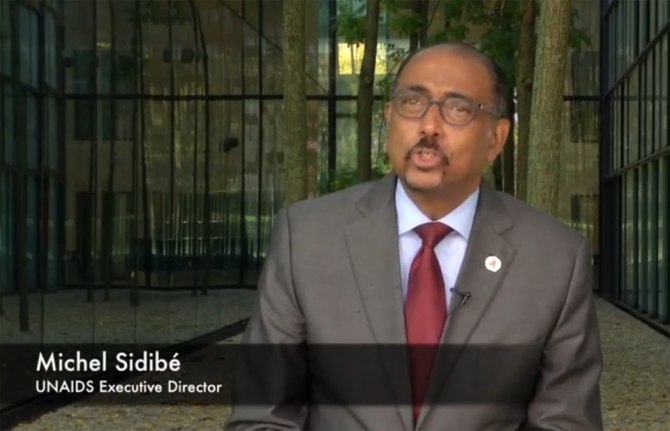国連合同エイズ計画(UNAIDS)の公式サイトにミシェル・シディベ事務局長の世界エイズデーに寄せるメッセージがプレス声明として掲載されました。その日本語仮訳です。一応、12月1日付になっていますが、今日は11月28日なので、ちょっと前倒しです。当日発表しても、2、3日前に発表しても、内容は変わらないので、もう出しちゃえという感じでしょうか。メディアが素材として活用するには、ちょっと早めに流しておく必要があると考えたのかもしれません。以前なら11月30日の何時解禁みたいなエンバーゴ付きでメディアには事前に情報提供するという方式でしたが、ネットで一括公開して扱いはご自由にという方が発進性は高いということでしょうね。
UNAIDSは11月21日に世界エイズデーに向けた恒例の報告書を発表し、新たな戦略として今年は「ライフサイクル・アプローチ」を打ち出しています。事務局長メッセージもそれを踏襲した内容ですね。UNAIDSのサイトには動画も載っています。

世界エイズデー2016メッセージ プレス声明
ミシェル・シディベ 国連合同エイズ計画(UNAIDS)事務局長、国連事務次長
本日は世界エイズデーです。最初の症例報告以来、HIVに感染した人は世界で7800万人に達しています。私たちはその7800万人とともにあり、エイズ関連の疾病で亡くなったそのうちの3500万人のことを忘れてはいません。
持続可能な開発目標(SDGs)のもとで、世界は2030年のエイズ流行終結を約束しています。多くの国がそのために高速対応をとろうとしています ― 1800万人がすでに延命効果の高いHIV治療を受けており、母子感染の実質的な排除状態を達成する国も次々に出ています。
エイズの流行に対する闘いは勝利に向かって進んでいますが、それでもすべての分野で成果が上がっているというわけではありません。成人のHIV感染は減少していないし、若い女性はとりわけHIV感染の高いリスクにさらされています。
サハラ以南のアフリカでは大人になろうとする少女たちが非常に危険な年齢であることも私たちは認識しています。若い女性は、HIV感染の高いリスク、低いHIV検査率、HIV治療継続の困難さの三重の脅威にさらされているのです。
HIV陽性者の結核(TB)、子宮頸がん、C型肝炎などの重感染が続くと、エイズ関連の死者を2020年までに50万人未満に減らす目標の達成は難しくなります。2015年にはエイズ関連の死亡原因の3分の1は結核でした。またHIV陽性の女性は、子宮頸がんのリスクが4倍から5倍、高くなります。エイズだけに対応しようとする発想から脱することが不可欠です。
治療へのアクセスによりHIV陽性者は長く生きられるようになりました。治療に投資する価値はあります。ただし、50歳以上のHIV陽性者は、治療を受けている人も含め、加齢に伴う非感染症の罹患リスクが拡大し、それがHIV感染症の進行にも影響しています。
エイズは終わっていません。ただし、年齢に応じ、それぞれのニーズに対応していくことができれば終結は可能です。個々の状況がどんなものであれ、HIV感染から自らを守るツールを確保し、必要なら抗レトロウイルス治療へのアクセスを提供する必要があります。すべての人が人生の各段階でHIVに対応できるよう解決策を用意するライフサイクル・アプローチをとれば、HIVがもたらす複雑な課題にも対応できます。人が生きていく中でリスクも課題も変化します。誕生から高齢期まで、それぞれに状況に対応した予防と治療の戦略が必要です。
これまでの成果は将来に希望が持てるものではありますが、ここで満足することはできません。いま手を緩めることはできないのです。子ども達がHIVに感染せずに生まれ、若者がHIVに感染せずに成長し、そしてHIVに感染した人がエイズ発症を防げる治療をもっと受けやすくなるように、いまこそ力を合わせて前進する時なのです。
Press statement
World AIDS Day message 2016
Michel Sidibé, Executive Director of UNAIDS, Under-Secretary-General of the United Nations
Today, we commemorate World AIDS Day—we stand in solidarity with the 78 million people who have become infected with HIV and remember the 35 million who have died from AIDS-related illnesses since the first cases of HIV were reported.
The world has committed to end the AIDS epidemic by 2030 as part of the Sustainable Development Goals. We are seeing that countries are getting on the Fast-Track—more than 18 million people are on life-saving HIV treatment and country after country is on track to virtually eliminate HIV transmission from mother to child.
We are winning against the AIDS epidemic, but we are not seeing progress everywhere. The number of new HIV infections is not declining among adults, with young women particularly at risk of becoming infected with HIV.
We know that for girls in sub-Saharan Africa, the transition to adulthood is a particularly dangerous time. Young women are facing a triple threat: a high risk of HIV infection, low rates of HIV testing and poor adherence to HIV treatment.
Coinfections of people living with HIV, such as tuberculosis (TB), cervical cancer and hepatitis C, are at risk of putting the 2020 target of fewer than 500 000 AIDS-related deaths out of reach. TB caused about a third of AIDS-related deaths in 2015, while women living with HIV are at four to five times greater risk of developing cervical cancer. Taking AIDS out of isolation remains an imperative if the world is to reach the 2020 target.
With access to treatment, people living with HIV are living longer. Investing in treatment is paying off, but people older than 50 who are living with HIV, including people who are on treatment, are at increased risk of developing age-associated noncommunicable diseases, affecting HIV disease progression.
AIDS is not over, but it can be if we tailor the response to individual needs at particular times in life. Whatever our individual situation may be, we all need access to the tools to protect us from HIV and to access antiretroviral medicines should we need them. A life-cycle approach to HIV that finds solutions for everyone at every stage of life can address the complexities of HIV. Risks and challenges change as people go through life, highlighting the need to adapt HIV prevention and treatment strategies from birth to old age.
The success we have achieved so far gives us hope for the future, but as we look ahead we must remember not to be complacent. We cannot stop now. This is the time to move forward together to ensure that all children start their lives free from HIV, that young people and adults grow up and stay free from HIV and that treatment becomes more accessible so that everyone stays AIDS-free.